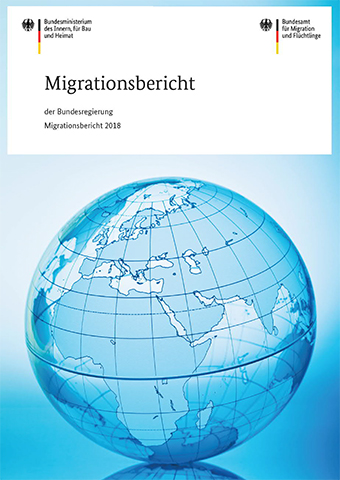The 2018 Migration Report ,
 Source: © iStock | Kasia Biel (cover image)
Source: © iStock | Kasia Biel (cover image)
The 2018 Migration Report prepared by the Federal Office for Migration and Refugees was presented by the Federal Ministry of the Interior, Building and Community on 8 January 2020. In addition to comprehensive migration data on Germany, the report also contains a comparison of migration flows and asylum within Europe. It deals with the phenomenon of irregular migration, and provides information on the structure and development of the population with a migration background in Germany.
Main results
A slight decline in net immigration
The number of people moving to Germany was slightly higher in 2018 than in 2017. There were approximately 1.59 million new arrivals (as against 1.55 million in the previous year). The number of departures increased at the same time, reaching roughly 1.19 million persons (as against 1.13 million in the previous year), so that the migration balance fell in 2018 to just under 400,000 persons (as against 416,000 in the previous year).
Two-thirds of immigrants come from Europe
Migration to Germany is characterised above all by arrivals and departures from and to other European countries. This meant that roughly 67 percent of all immigrants were from another European country in 2018, 53 percent of them came from Member States of the EU. A particularly large proportion of these are nationals of Romania, Poland and Bulgaria, who headed the list of main countries of origin in 2018.
Fewer asylum applications – family reunification is also falling
The number of asylum applications reflects the marked decline in forced migration: Whilst as many as 198,317 first asylum applications were received in 2017, the number fell by 18.3 percent in 2018 to 161,931, 32,303 (19.9 percent) of them were asylum applications of children who were born in Germany and less than one year old. Family reunification of third-country nationals also declined by 15.4 percent in 2018 to 97,129 residence permits issued.
Attractive for studying and working
Germany is becoming increasingly attractive for foreign students: 109,995 students (as against 104,940 in the previous year) who had completed their higher education entrance qualification abroad began their studies at a German higher education institution in 2018. The number of foreign first-year students has thus reached a new high. The largest group was made up of Chinese nationals, followed by students from India and Syria. When it comes to labour migration, 60,857 residence permits were issued to immigrants from outside the European Union in 2018 (as against 60,882 in the previous year), including approximately 12,000 EU Blue Cards. The level of labour migration was thus roughly the same as in the previous year.
One person in four in Germany has a migration background
One person in four (25.5 per cent) living in private households in Germany in 2018 had a migration background, i.e. he or she or at least one parent did not have German citizenship from birth. 52.4 per cent of people with a migration background are German citizens, and more than a one-third (35.5 per cent) were born in Germany.
Notes on using the Migration Report

The Federal Office for Migration and Refugees prepares the Federal Government's Migration Report on an annual basis. The complete version of the Migration Report (in German only) can be downloaded on the German language site (link below). If you click on the figures in the PDF file of the migration report, you can download the data for the respective figures in Excel format.
A summary of the main results (in English and German) can be found under "Further information".

